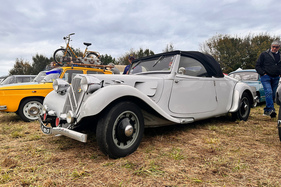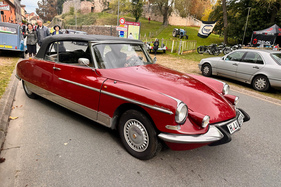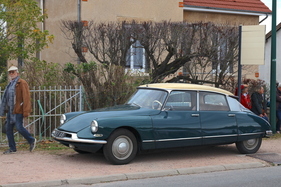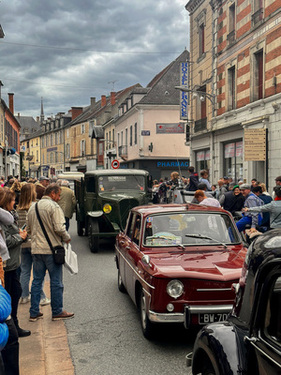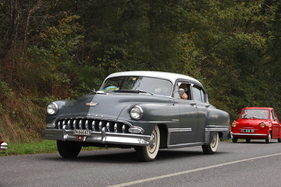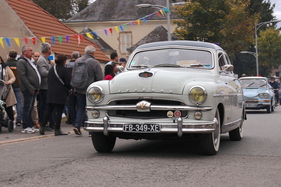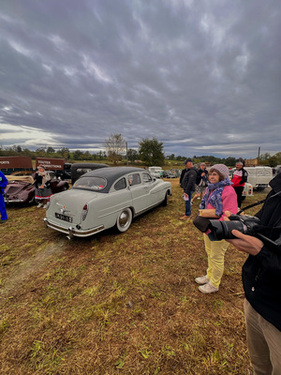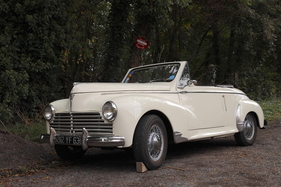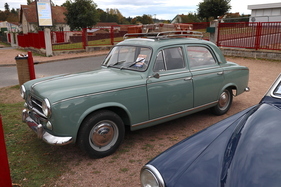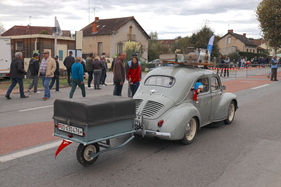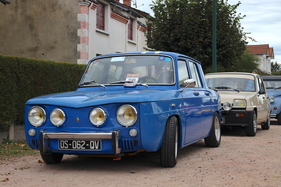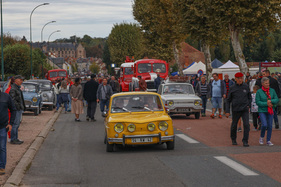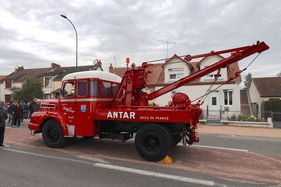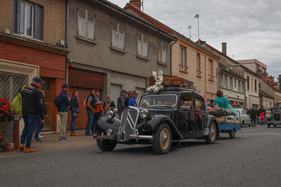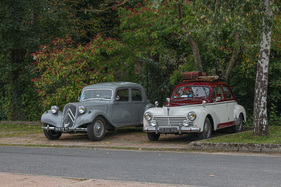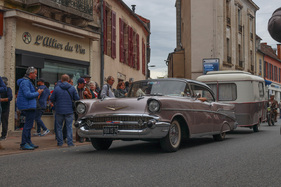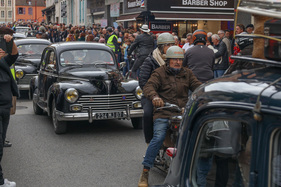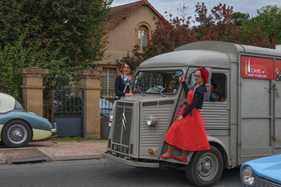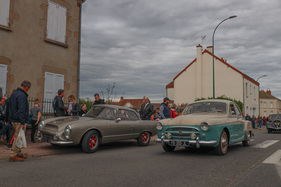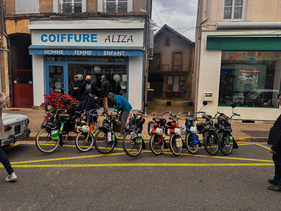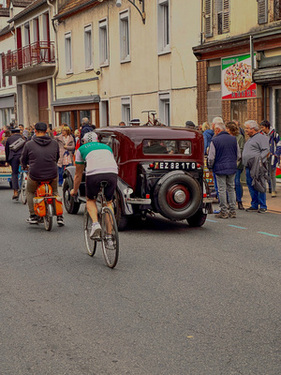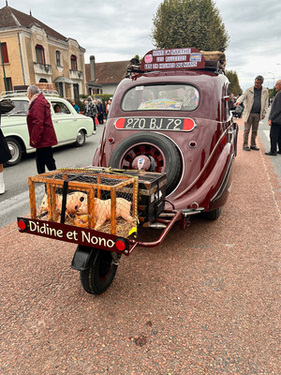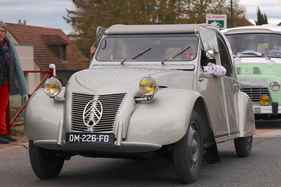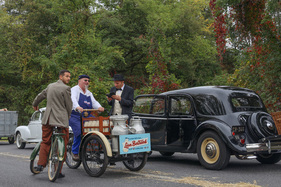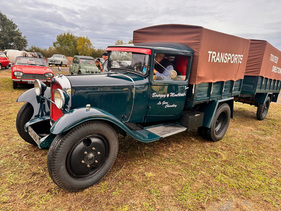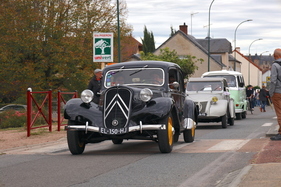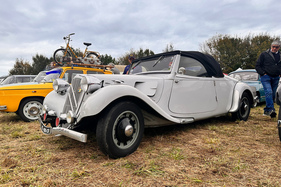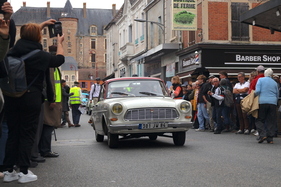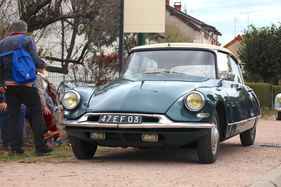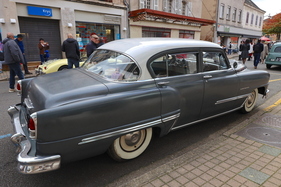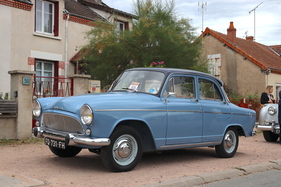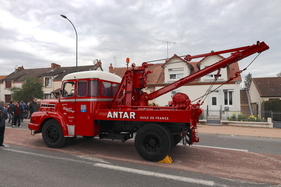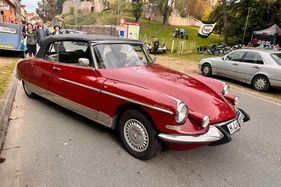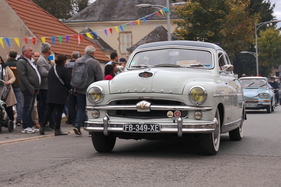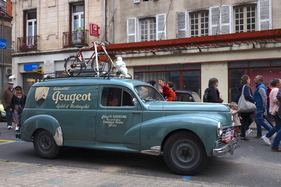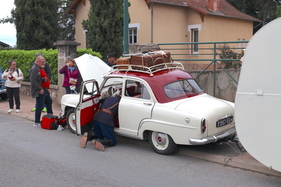After a two-year break, it was time again on the weekend of October 11 to 13: the town of Lapalisse was the scene of one of the craziest parties for historic vehicles ever. The reason for this is the village's location on the old Route Bleue, the Route Nationale 7, where travelers crowded at the beginning and end of the vacations from the 1950s to the early 1970s - because Lapalisse, with its narrow bridge and narrow main street, was a particular bottleneck on the Nationale 7 and its almost 1000-kilometre route from Paris down to the Côte d'Azur.
Too much peace and quiet thanks to the bypass
A highway to replace the main road has existed for over 50 years, but it was only in 2006 that Lapalisse got rid of the 3,000 or so trucks that passed through the town every week. The truck drivers did not want to pay the highway toll and continued to prefer the well-developed country road. Since 2006, there has been a bypass for the small town on the eastern edge of Auvergne.
French illustrator Thierry Dubois is an avowed fan and connoisseur of this old vacation route and its heyday some 60 years ago. He approached the municipality in 2006 with the idea of reviving the vacation traffic jam of yesteryear in a much more fun, colorful form. Lapalisse - now relieved of traffic, but literally cut off from a certain amount of added value from tourism - was delighted. For it is unmistakable that the great days of the hotels, the Relais Routiers, the restaurants and the once seven Stations Services - the petrol stations with workshops - in Lapalisse are over. Many a store is empty, and even the most beautiful buildings from the Art Deco era remain unoccupied today.
The fact that the municipality is fully behind the organized jam is already evident in the registration procedure. The modest 20 euro registration fee is paid directly into the Trésor National, the French state treasury, but into the account of the "Service Animation" of the "Communauté de Communes du Pays de Lapalisse", the United Communes of the region around Lapalisse. The administrator responsible for the traffic jam looks after the local associations and cultural events.
The golden age of travel
Vehicles between 1945 and 1969 are admitted to the Embouteillage, with a preference for French makes, but there are also some imported cars. The mix reflects the conditions of the time in the best possible way. It feels like there is one "tourist" in a Mercedes-Benz, American or English car for every 100 French cars. The vehicle types are also as varied as they once were: cars, coaches, trucks - but also the priest on a bicycle or the farmer with a cow (made of plastic) in a trailer. In short: anything with wheels that is at least 55 years old can be part of the Embouteillage.
But anyone who thinks this is just a parade of historic vehicles is mistaken. Loaded with plenty of luggage, the family carriages of yesteryear fight their way through the traffic and with it against overheating radiators and boiling gasoline in the carburetor. Most of the time, all the seats are occupied and the occupants wear period clothing. If the traffic is moving too fast - faster than walking pace - a flic jumps onto the road and trills his whistle. Whether the policeman is real or just an act is not quite clear. In any case, the motorcycles of the gendarmes equipped with smart boots bear the original license plates of the Gendarmerie Nationale. The use of sirens and blue lights is also extensively celebrated.
"Live happily - drink wine" is written on the cistern of a veritable tanker truck built on the chassis of a Willème LD 610. In France, the characteristic cab is known by the nickname "Nez de Réquin" ("Haufischschnauze"). The two dungaree-clad routers - who, incidentally, are well-versed in French truck history, as a conversation with them shows - do not transport wine, but it is always fun when they drive past the crowd with their loudly rumbling six-cylinder naturally aspirated diesel engine with a displacement of 13.5 liters and an output of 175 SAE hp.
Around 800 cars, about two dozen "Poids Lourds" and countless Mobylettes from Motobécane and Vélomoteurs from Vélosolex squeeze in between. Well, a fake priest gives his blessing and meanwhile looks after the (male) nuns riding past on their mopeds. Someone has unloaded the plastic cow and left the space in the trailer to an exuberant group of partying people. A VW T1 is transporting the offspring on the roof rack, and a Traction Avant is pulling a trailer with a mattress on which two ladies have made themselves comfortable while they, like all other road users, are zooming through the city at a snail's pace.
Pure joie de vivre
Many a pearl mingles with the mile-long convoy. A Citroën DS Palm Beach stands rather inconspicuously at the side of the road, the somewhat more ostentatious brother of the factory convertible. This was the self-designed "cut-up" presented by the coachbuilder from Levallois-Perret near Paris for the man and the elegant lady for whom the "official" convertible was too ordinary.
Keyword elegant ladies: Many take the opportunity to dress up in style. The men's world is delighted and follows suit in terms of elegance with hats, jackets and ties. A couple of mature age celebrate their wedding, which is probably a long time ago, in a pre-war Citroën with Normande bodywork, a mixture of wooden framework and open torpedo. The somewhat damaged-looking groom, as his red nose suggests, probably had to drink his bride to make her look good. There also seems to be an offspring: The driver of the Citroën is the youngest on board.
Meanwhile, the main street of Lapalisse is lined with a dense crowd. The Tour de France would probably be happy if it could get as many people out onto the streets. And this party goes on for miles. In every nook and cranny you discover a little production of its own. People with camping chairs and picnic tables sit by the roadside, and the two ladies from the art deco petrol station dressed in overalls make sure that the colorful parade is ready to march again. There are numerous refreshment stations for the cyclists - always overtaking the stationary column, of course. In contrast to the standard Swiss-style refreshments of sausage and bread (ideally accompanied by potato salad), choucroute royale or a veritable couscous await hungry mouths.
And yes, you also "live" richly and therefore happily, true to the motto of the Willème wine tanker. The room at the hotel is booked. An inspection the next morning reveals that many a car has been left parked next to or even in the middle of the road on the restricted area. The "Nez rouges" went to sleep on foot late at night.
Intangible cultural asset
If Goscinny and Uderzo were to invent two Gallic heroes in the present day instead of among the Romans, they would probably draw inspiration for their village festival scenes here. And anyone who remembers with a little nostalgia the time when there were still customs barriers between European countries, but a separate universe could be discovered behind each border; anyone who thought all those differences were lost will find them here. The French drive the French and do everything you would expect from them: they are warm, boisterous, loud and full of mischief. No matter how much the Flics trill around with their whistles, you won't be put off.
And in between all the hustle and bustle, there are people sitting somewhere, treating themselves to something good for the palate and enjoying the pleasures of life. As a festival of the yearnings of the little man, who in the 1950s and 1960s was able to enjoy a sense of freedom and a few days off for the first time thanks to mass motorization; as an event that reflects everyday culture, France should include the Embouteillage in its register of intangible cultural assets. But the very best thing about the Embouteillage is that its own success will hardly stand in its way, because the traffic jam is part of the program, the confusion is intentional and the crowds of all those 30,000 enthusiasts who make the pilgrimage to Lapalisse are quite deliberate. C'est formidable! The next edition will take place in 2026.











